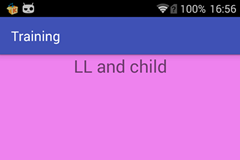Android LayoutInflater.inflater方法详解
2016-10-08 20:50
381 查看
摘要: 源自一次随便玩玩的实验,只想尝试尝试不同的参数设置时inflate方法的表现,却发现自己怎么也无法理解实验结果,便引发了自己关于该方法的深入思考,先将自己的理解记录如下,希望对那些和我有同样困惑的人能有点帮助,也加强自己的深入理解。
public View inflate(@LayoutRes int resource, @Nullable ViewGroup root)
public View inflate(XmlPullParser parser, @Nullable ViewGroup root)
public View inflate(@LayoutRes int resource, @Nullable ViewGroup root, boolean attachToRoot)
public View inflate(XmlPullParser parser, @Nullable ViewGroup root, boolean attachToRoot)
root:一个可选的ViewGroup对象,当attachToRoot为true时,root为生成的view树的parent;当attachToRoot为false时,root仅为一个为生成的视图层次提供参数的对象
attachToRoot:是否将生成的视图层次附加到root参数上,false:root仅仅用于为xml文件的根节点创建正确的参数子类
Case1:当参数root == null时,函数调用为inflate(parser, null)
Case2:当参数root != null && attachToRoot == false时,函数调用为inflate(parser, root, false)
Case3:当参数root != null && attachToRoot == true时,函数调用为inflate(parser, root, true)
那么如上几种参数场景都会有怎样的返回值呢?我们接下来一起看看inflate方法内部的实现吧!
layout_root:
layout_child:
所以由4中的分析可知,3中3种case下面的返回值分别为:
Case1:返回id为ll_child的LinearLayout视图,该view的LayoutParams为null
Case2:返回id为ll_child的LinearLayout视图,该view的LayoutParams为xml文件layout_child中提供的参数,即width和height分别为200dp和200dp
Case3:返回id为ll_root的LinearLayout视图,该view的LayoutParams为xml文件layout_root中提供的参数,即width和height分别为300dp和400dp,同时由于这是一个vertical的LinearLayout,所以会将layout_child所代表的view树添加到id为tv_child_ll的TextView下面
Case1:
实验结果:

结果分析:由5可知,该情况下返回的是一个LayoutParams == null,根节点id为ll_child的LinearLayout,至于为什么显示效果如上图所示则涉及到setContentView方法以及Android的窗口加载原理,简而言之就是在Android加载布局文件时,如果view的LayoutParams为null,则默认将该view的width和height赋值为MATCH_PARENT,具体请参考我的下一篇博客《Android 从setContentView谈Activity界面的加载过程》
Case2:
实验结果:

结果分析:由上图可以看出,该情况与5中的分析相符
Case3:
实验结果:

结果分析:由上图可以看出,该情况与5中的分析相符
一、简介
inflate方法是LayoutInflater类中的一个公有方法,该方法共有4个重载的方法原型,不过看源码便知,如下方法1,2,3最后兜兜转转都调用了方法4:public View inflate(@LayoutRes int resource, @Nullable ViewGroup root)
public View inflate(XmlPullParser parser, @Nullable ViewGroup root)
public View inflate(@LayoutRes int resource, @Nullable ViewGroup root, boolean attachToRoot)
public View inflate(XmlPullParser parser, @Nullable ViewGroup root, boolean attachToRoot)
二、主要方法详解
参数:
parser:一个xml dom节点,在该节点中包含了待生成的视图层次结构的描述信息root:一个可选的ViewGroup对象,当attachToRoot为true时,root为生成的view树的parent;当attachToRoot为false时,root仅为一个为生成的视图层次提供参数的对象
attachToRoot:是否将生成的视图层次附加到root参数上,false:root仅仅用于为xml文件的根节点创建正确的参数子类
返回:
返回生成的view树的根节点参数组合:
(注:参数parser不能为空,若为空,会提示错误):Case1:当参数root == null时,函数调用为inflate(parser, null)
Case2:当参数root != null && attachToRoot == false时,函数调用为inflate(parser, root, false)
Case3:当参数root != null && attachToRoot == true时,函数调用为inflate(parser, root, true)
那么如上几种参数场景都会有怎样的返回值呢?我们接下来一起看看inflate方法内部的实现吧!
inflate方法源码分析:
public View inflate(XmlPullParser parser, @Nullable ViewGroup root,
boolean attachToRoot) {
synchronized (mConstructorArgs) {
final Context inflaterContext = mContext;
/*
* attrs:从给定的parser中获得的一个xml属性集,我们一般不会直接使用该类型参数
* 所以不用管,只需知道attrs中包含了我们传进去的layout文件中所定义的参数属性值便好
*/
final AttributeSet attrs = Xml.asAttributeSet(parser);
Context lastContext = (Context) mConstructorArgs[0];
mConstructorArgs[0] = inflaterContext;
/* result为待返回的View对象 */
View result = root;
/*
* 这里有一段代码,未贴出来 功能:寻找xml中的根节点,找到时将起始节点的名称赋值给name 若没有找到则抛异常
*/
if (TAG_MERGE.equals(name)) {
// 当根节点为merge节点时的处理
if (root == null || !attachToRoot) {
throw new InflateException(
"<merge /> can be used only with a valid "
+ "ViewGroup root and attachToRoot=true");
}
/*
* 这是一个递归方法,从xml根节点开始向下递归,先初始化该层view,
* 然后初始化下一层view,当整个view树都生成完毕时调用onFinishInflate()
* 接下来我们就可以通过findViewById方法找到具有id属性的view了
*/
rInflate(parser, root, inflaterContext, attrs, false);
} else {
// 根节点不为merge节点时的处理
/*
* temp为xml文件中的根节点view
* createViewFromTag方法用于根据给定的参数集attrs为名为name的tag标签生成一个view
* 由上文可知,此处name为xml文件的根节点名称,所以temp为xml的root view
*/
final View temp = createViewFromTag(root, name,
inflaterContext, attrs);
ViewGroup.LayoutParams params = null;
if (root != null) {
// 注意:root非空时的处理
// Create layout params that match root, if supplied
/*
* generateLayoutParams是ViewGroup中提供的一个public方法
* 用于根据给定的参数集attrs生成一个LayoutParams
* LayoutParams一般由view使用,用于告诉view的parent,他们想要的layout样式
* 一个基本的LayoutParams一般只用于描述他们的size信息,即view的width和height
*
* 注意:此处通过root来调用generateLayoutParams得到了一个LayoutParams对象
*/
params = root.generateLayoutParams(attrs);
if (!attachToRoot) {
/*
* 当root != null && attachToRoot == false时(即前面说的Case2)
* 用params所指代的LayoutParams为tamp设置布局参数
*/
temp.setLayoutParams(params);
}
}
// Inflate all children under temp against its context.
rInflateChildren(parser, temp, attrs, true);
/*
* 当root != null && attachToRoot == true时(即前面说的Case3)
* 将根节点为temp的view树添加到root上,temp的布局参数为params
*/
if (root != null && attachToRoot) {
root.addView(temp, params);
}
/*
* 当root == null || !attachToRoot时(前面说的Case1和Case2属于这种情况)
* 将temp赋值给result
*/
if (root == null || !attachToRoot) {
result = temp;
}
}
/*
* 返回得到的view树的根节点
*
* 注意:不同情况下的result值是不一样的
* 当root == null时,result为xml根节点view,但并未为该view设置LayoutParams值
* 当root != null && attachToRoot == false时
* result为xml根节点view,且根据xml文件中提供的参数值为该view设置了LayoutParams值
* 当root != null && attachToRoot == true时,result为初始值root
*/
return result;
}
}参数组合结果:
假设root 的xml文件为layout_root,待infalte的xml文件为layout_child:layout_root:
<?xml version="1.0" encoding="utf-8"?> <LinearLayout xmlns:android="http://schemas.android.com/apk/res/android" android:id="@+id/ll_root" android:orientation="vertical" android:layout_width="300dp" android:layout_height="400dp" android:background="@color/forestgreen" > <TextView android:id="@+id/tv_root_ll" android:layout_width="wrap_content" android:layout_height="wrap_content" android:text="LL and root" android:layout_gravity="center_horizontal" android:textSize="20sp" /> </LinearLayout>
layout_child:
<?xml version="1.0" encoding="utf-8"?> <LinearLayout xmlns:android="http://schemas.android.com/apk/res/android" android:id="@+id/ll_child" android:orientation="vertical" android:layout_width="200dp" android:layout_height="200dp" android:background="@color/violet" > <TextView android:id="@+id/tv_child_ll" android:layout_width="wrap_content" android:layout_height="wrap_content" android:text="LL and child" android:layout_gravity="center_horizontal" android:textSize="20sp" /> </LinearLayout>
所以由4中的分析可知,3中3种case下面的返回值分别为:
Case1:返回id为ll_child的LinearLayout视图,该view的LayoutParams为null
Case2:返回id为ll_child的LinearLayout视图,该view的LayoutParams为xml文件layout_child中提供的参数,即width和height分别为200dp和200dp
Case3:返回id为ll_root的LinearLayout视图,该view的LayoutParams为xml文件layout_root中提供的参数,即width和height分别为300dp和400dp,同时由于这是一个vertical的LinearLayout,所以会将layout_child所代表的view树添加到id为tv_child_ll的TextView下面
实验:
下面根据上面三种case分别进行实验,查看显示效果Case1:
private void caseOne(){
childView = inflater.inflate(R.layout.layout_child, null);
setContentView(childView);
}实验结果:

结果分析:由5可知,该情况下返回的是一个LayoutParams == null,根节点id为ll_child的LinearLayout,至于为什么显示效果如上图所示则涉及到setContentView方法以及Android的窗口加载原理,简而言之就是在Android加载布局文件时,如果view的LayoutParams为null,则默认将该view的width和height赋值为MATCH_PARENT,具体请参考我的下一篇博客《Android 从setContentView谈Activity界面的加载过程》
Case2:
private void caseTwo(){
rootView = (ViewGroup)inflater.inflate(R.layout.layout_root,null);
childView = inflater.inflate(R.layout.layout_child, rootView, false);
setContentView(childView);
}实验结果:

结果分析:由上图可以看出,该情况与5中的分析相符
Case3:
private void caseThree(){
rootView = (ViewGroup)inflater.inflate(R.layout.layout_root,null);
childView = inflater.inflate(R.layout.layout_child, rootView, true);
setContentView(childView);
}实验结果:

结果分析:由上图可以看出,该情况与5中的分析相符
相关文章推荐
- Android编程之LayoutInflater的inflate方法详解
- Android编程之LayoutInflater的inflate方法详解
- [读书笔记]Android LayoutInflater.inflate方法参数详解原理分析
- Android编程之LayoutInflater的inflate方法详解
- Android编程之LayoutInflater的inflate方法详解
- Android LayoutInflater.inflate()方法参数详解
- Android编程之LayoutInflater的inflate方法详解
- [Android]inflate方法与 findViewById 方法区别 | LayoutInflater的inflate函数用法详解
- 【android】LayoutInflater.inflate方法的详解及xml根元素的布局参数不起作用的问题
- android-----LayoutInflater的inflate方法详解
- [Android]LayoutInflater的inflate方法半详解
- 【android】LayoutInflater.inflate方法的详解及xml根元素的布局参数不起作用的问题
- Android编程之LayoutInflater的inflate方法详解
- Android编程之LayoutInflater的inflate方法示例详解(超赞哦)
- 【android】LayoutInflater.inflate方法的详解及xml根元素的布局参数不起作用的问题 - u011494050的专栏 - 博客频道 - CSDN.NET
- Android编程之LayoutInflater的inflate方法详解
- [Android]inflate方法与 findViewById 方法区别 | LayoutInflater的inflate函数用法详解
- Android编程之LayoutInflater的inflate方法详解及其中参数的作用
- Android编程之LayoutInflater的inflate方法详解
- Android编程之LayoutInflater的inflate方法详解
